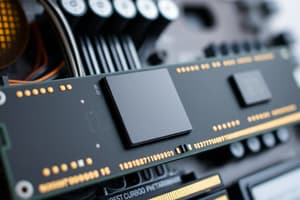Podcast
Questions and Answers
What is the function of the Central Processing Unit (CPU) in a computer system?
What is the function of the Central Processing Unit (CPU) in a computer system?
Executing instructions and processing data
Differentiate between volatile and non-volatile memory.
Differentiate between volatile and non-volatile memory.
Volatile memory loses its contents when power is turned off, while non-volatile memory retains its contents.
Name two specialized processors apart from general-purpose CPUs.
Name two specialized processors apart from general-purpose CPUs.
Graphics Processing Units (GPUs) and Digital Signal Processors (DSPs)
Why is the motherboard considered the main circuit board of a computer?
Why is the motherboard considered the main circuit board of a computer?
How does the amount and type of memory installed in a computer impact its performance?
How does the amount and type of memory installed in a computer impact its performance?
Give an example of a non-volatile memory device.
Give an example of a non-volatile memory device.
What is the main function of a motherboard?
What is the main function of a motherboard?
How does the capacity and speed of a hard drive affect a computer's performance?
How does the capacity and speed of a hard drive affect a computer's performance?
What role do monitors play in a computer system?
What role do monitors play in a computer system?
What is the function of a power supply in a computer system?
What is the function of a power supply in a computer system?
Give examples of input devices in a computer system.
Give examples of input devices in a computer system.
How is software different from hardware?
How is software different from hardware?
Flashcards are hidden until you start studying
Study Notes
Computer Hardware
Overview
Computer hardware refers to the physical components of a computer system, such as the central processing unit (CPU), memory, storage devices, and input/output (I/O) peripherals. These components work together to process data, store information, and communicate with external devices. Hardware includes not only the main components of a computer but also any external devices that connect to it, such as monitors, keyboards, and printers.
Central Processing Unit (CPU)
The CPU is the heart of a computer system. It's responsible for executing instructions and processing data. CPUs come in different types, including general-purpose CPUs and specialized processors like graphics processing units (GPUs) and digital signal processors (DSPs). As technology advances, CPUs continue to become more powerful and efficient, enabling faster and more complex computations.
Memory
Memory is where data and programs are stored temporarily. There are two main types of memory: volatile and non-volatile. Volatile memory, such as random access memory (RAM), loses its contents when the power is turned off. Non-volatile memory, like flash drives and disk drives, retains its contents even after the power is off. The amount and type of memory installed in a computer can significantly impact its performance.
Motherboard
The motherboard is the main circuit board of a computer. It connects all the other components, such as the CPU, memory, and storage devices, and provides slots for expansion cards and sockets for devices like modems. The motherboard also contains connectors for video cards and other I/O peripherals.
Hard Drive
Hard drives are used to store files, music, pictures, videos, and other digital content. They connect to the computer via USB, FireWire, or eSATA ports. Hard drives come in various sizes, including 5.25 inches, 3.5 inches, 2.5 inches, and 1.8 inches. The capacity and speed of a hard drive can affect a computer's performance.
Monitor
Monitors display images on a screen. They vary in size, resolution, and price. Flat panel monitors have become popular due to their sleek design and low profile. The quality of a monitor can impact the user's experience when using a computer.
Power Supply
Power supplies convert electricity from AC outlets to DC voltages that run the computer. They are essential for providing power to all the components within a computer system. The efficiency and reliability of a power supply can affect a computer's performance and lifespan.
External Hardware
External hardware devices, or peripherals, are not built into the computer but are connected to it via cables or wireless connections. Examples of external hardware include:
- Input devices: These include peripherals that allow users to enter information into a computer, such as keyboards, mice, touchpads, touchscreens, joysticks, microphones, light pens, and webcams.
- Output devices: These are devices that receive information from a computer and provide an output, such as monitors, printers, scanners, speakers, display screens (tablets, smartphones, etc.), projectors, and headphones.
Software
Software is the set of instructions that tells the hardware what to do. It runs on the hardware to perform various tasks, from basic to complex operations. Software can be categorized into two main types:
- System software: This type of software is responsible for managing and controlling the hardware, operating systems, device drivers, and utility software that helps set up, analyze, configure, strengthen, and maintain a computer.
- Application software: This software provides users with tools to accomplish specific tasks, such as word processing, spreadsheets, presentation, database management, Internet browsers, email programs, media players, accounting, and enterprise software.
Conclusion
Understanding the relationship between hardware and software is crucial for anyone working with computers. Hardware provides the physical components that allow a computer to function, while software provides the instructions for the hardware to perform tasks. By understanding the roles and properties of both hardware and software, users can make the most of their technology and troubleshoot issues more effectively.
Studying That Suits You
Use AI to generate personalized quizzes and flashcards to suit your learning preferences.




